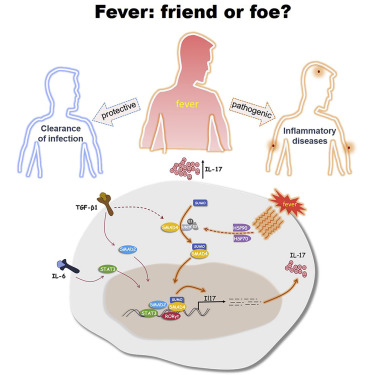Our official English website, www.x-mol.net, welcomes your
feedback! (Note: you will need to create a separate account there.)
Febrile Temperature Critically Controls the Differentiation and Pathogenicity of T Helper 17 Cells.
Immunity ( IF 25.5 ) Pub Date : 2020-02-11 , DOI: 10.1016/j.immuni.2020.01.006 Xiaohu Wang 1 , Lu Ni 1 , Siyuan Wan 1 , Xiaohong Zhao 1 , Xiao Ding 1 , Anne Dejean 2 , Chen Dong 3
Immunity ( IF 25.5 ) Pub Date : 2020-02-11 , DOI: 10.1016/j.immuni.2020.01.006 Xiaohu Wang 1 , Lu Ni 1 , Siyuan Wan 1 , Xiaohong Zhao 1 , Xiao Ding 1 , Anne Dejean 2 , Chen Dong 3
Affiliation

|
Fever, an evolutionarily conserved physiological response to infection, is also commonly associated with many autoimmune diseases, but its role in T cell differentiation and autoimmunity remains largely unclear. T helper 17 (Th17) cells are critical in host defense and autoinflammatory diseases, with distinct phenotypes and pathogenicity. Here, we show that febrile temperature selectively regulated Th17 cell differentiation in vitro in enhancing interleukin-17 (IL-17), IL-17F, and IL-22 expression. Th17 cells generated under febrile temperature (38.5°C-39.5°C), compared with those under 37°C, showed enhanced pathogenic gene expression with increased pro-inflammatory activities in vivo. Mechanistically, febrile temperature promoted SUMOylation of SMAD4 transcription factor to facilitate its nuclear localization; SMAD4 deficiency selectively abrogated the effects of febrile temperature on Th17 cell differentiation both in vitro and ameliorated an autoimmune disease model. Our results thus demonstrate a critical role of fever in shaping adaptive immune responses with implications in autoimmune diseases.
中文翻译:

适度的温度严格控制T辅助17细胞的分化和致病性。
发烧是一种对感染的进化上保守的生理反应,通常也与许多自身免疫性疾病有关,但在T细胞分化和自身免疫中的作用仍不清楚。T辅助细胞17(Th17)细胞在宿主防御和自身炎性疾病中至关重要,具有独特的表型和致病性。在这里,我们显示高热温度在增强白介素17(IL-17),IL-17F和IL-22表达的同时,选择性地调节Th17细胞的分化。与37℃下相比,在高热温度下(38.5°C-39.5°C)生成的Th17细胞显示出增强的致病基因表达,体内促炎活性增加。从机械上讲,发热温度促进了SMAD4转录因子的SUMOylation,以促进其核定位。SMAD4缺乏在体外选择性地消除了发热温度对Th17细胞分化的影响,并改善了自身免疫性疾病模型。因此,我们的结果证明了发烧在影响自身免疫性疾病的适应性免疫应答中起着至关重要的作用。
更新日期:2020-02-11
中文翻译:

适度的温度严格控制T辅助17细胞的分化和致病性。
发烧是一种对感染的进化上保守的生理反应,通常也与许多自身免疫性疾病有关,但在T细胞分化和自身免疫中的作用仍不清楚。T辅助细胞17(Th17)细胞在宿主防御和自身炎性疾病中至关重要,具有独特的表型和致病性。在这里,我们显示高热温度在增强白介素17(IL-17),IL-17F和IL-22表达的同时,选择性地调节Th17细胞的分化。与37℃下相比,在高热温度下(38.5°C-39.5°C)生成的Th17细胞显示出增强的致病基因表达,体内促炎活性增加。从机械上讲,发热温度促进了SMAD4转录因子的SUMOylation,以促进其核定位。SMAD4缺乏在体外选择性地消除了发热温度对Th17细胞分化的影响,并改善了自身免疫性疾病模型。因此,我们的结果证明了发烧在影响自身免疫性疾病的适应性免疫应答中起着至关重要的作用。











































 京公网安备 11010802027423号
京公网安备 11010802027423号